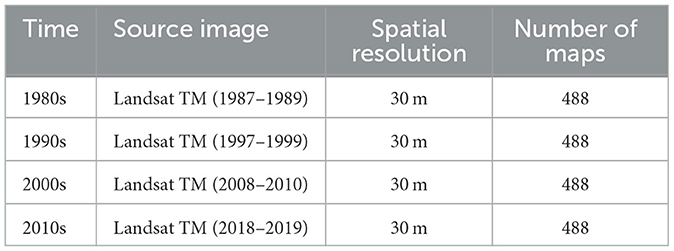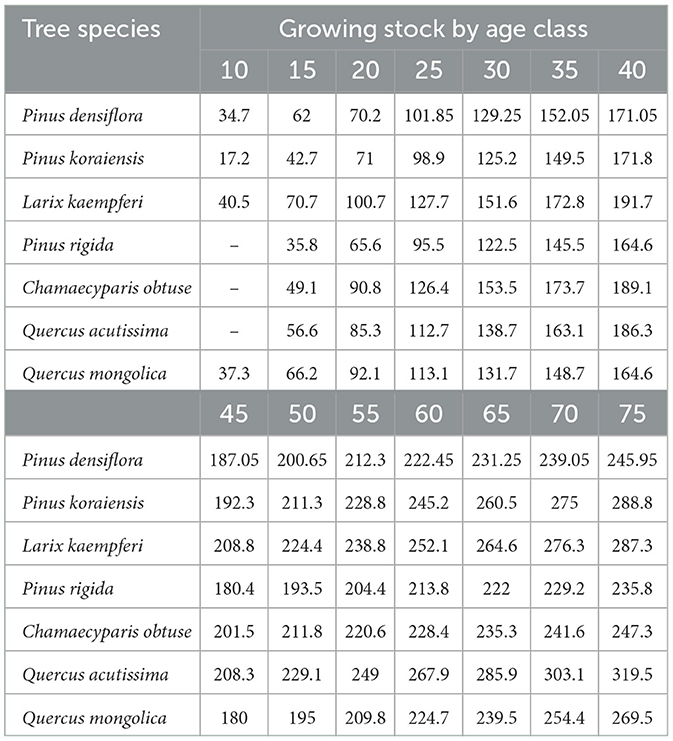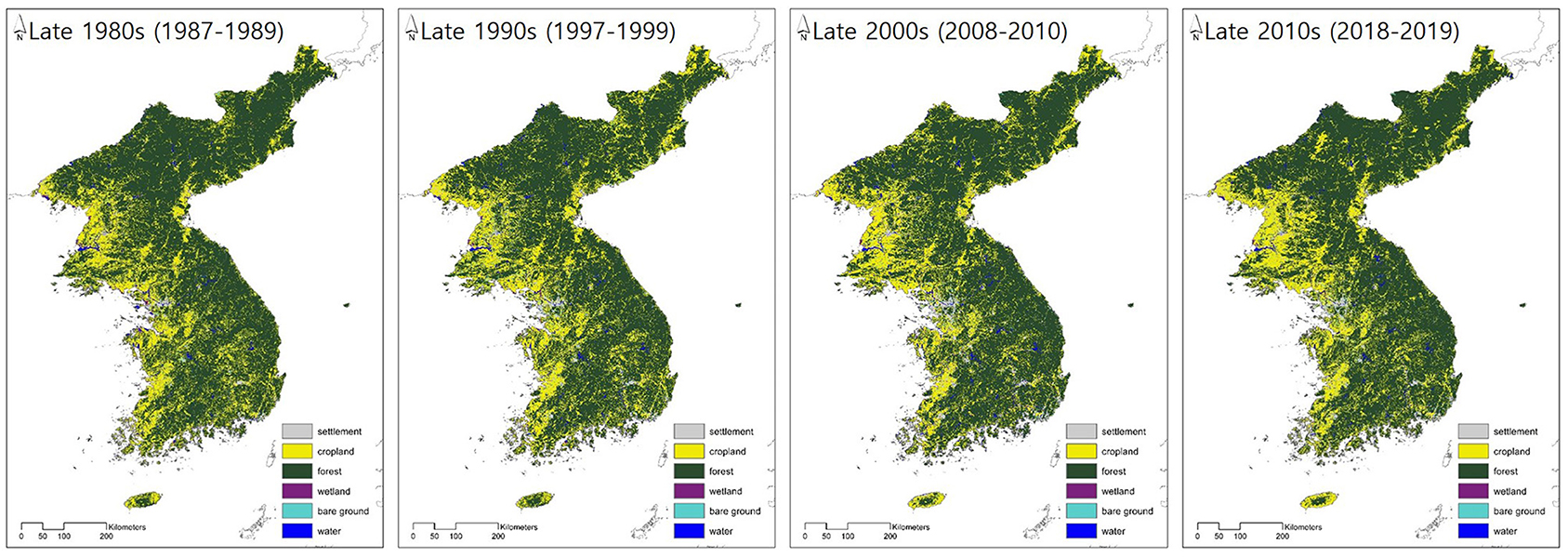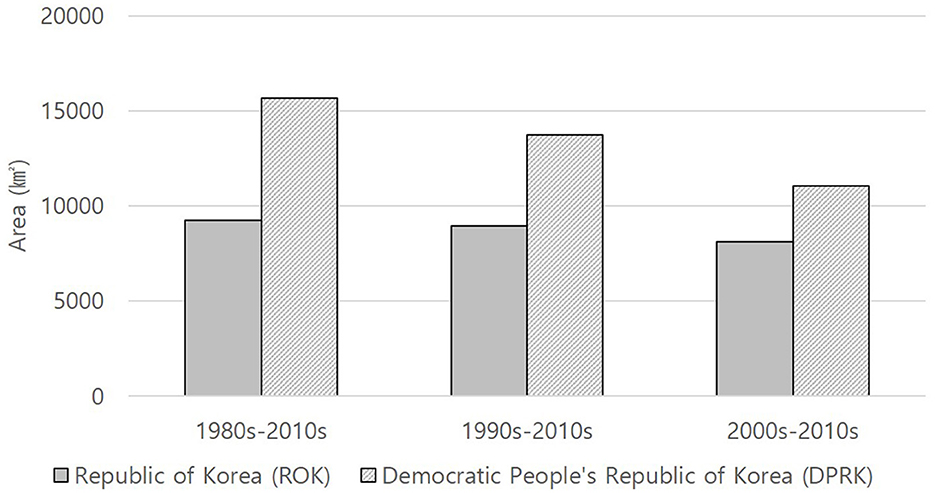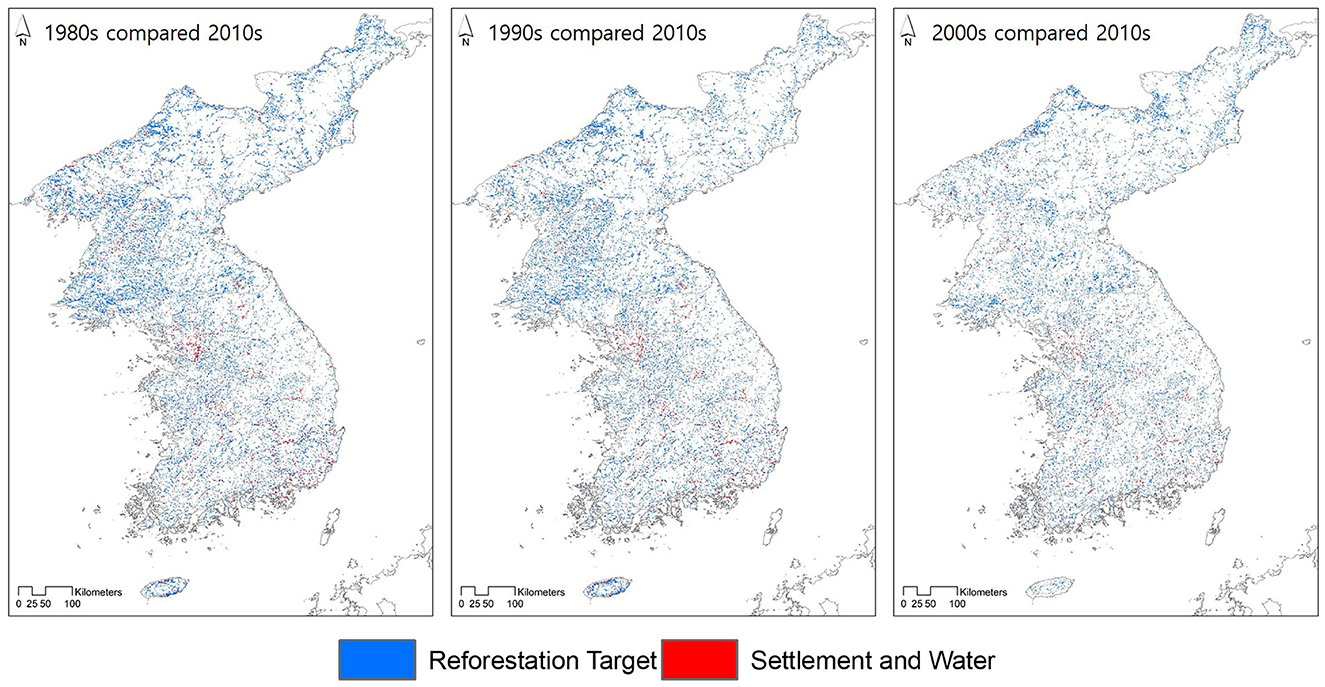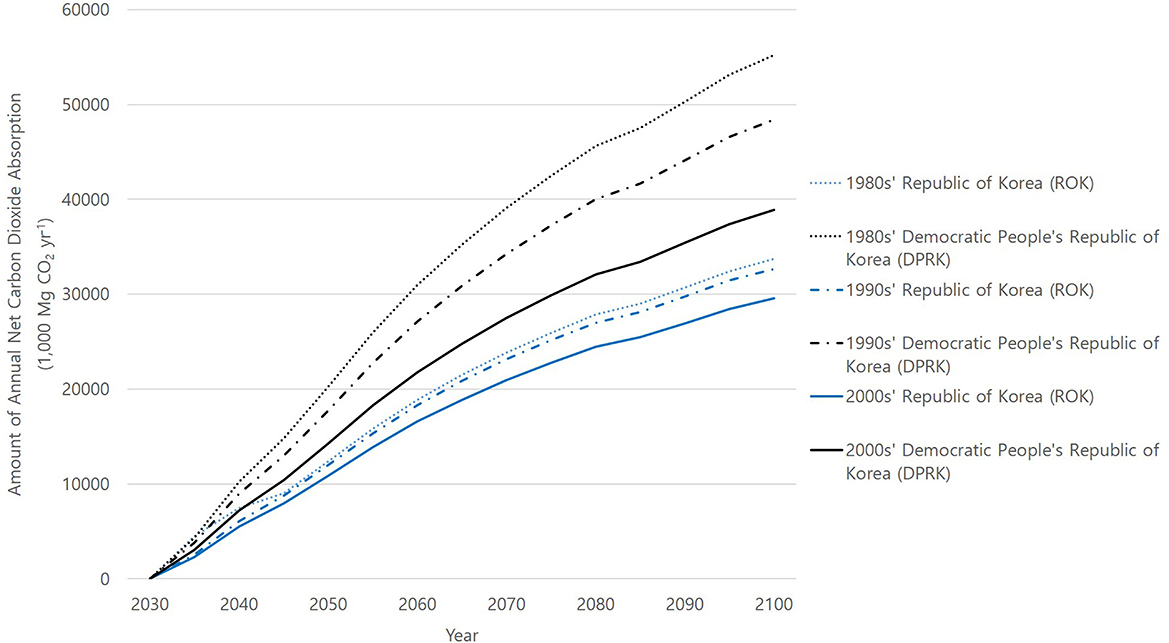- 1Forest Resource Research Center, Chonnam National University, Gwangju, Republic of Korea
- 2Department of Forest Resources, Chonnam National University, Gwangju, Republic of Korea
A forest is one of the carbon sinks in the terrestrial ecosystem; it is a major target for securing CO2 sequestration to achieve carbon neutrality. Reforestation is a forest management method that could attain carbon fixation and forest degradation recovery at the same time, but quantitative research has not been actively conducted. The purpose of this study is to identify the target areas for reforestation through changes in land cover in the Korean Peninsula and to quantify the potential CO2 sequestration effect of reforestation. According to the land cover change through satellite imagery, the area of settlements in the Republic of Korea (ROK) was the most dominant (+3,371 km2), and the main change occurred from cropland to settlements. The forest area increased by +1,544 km2 from 68,264 km2 in the 1980s to 69,809 km2 in the late 2010s. The forest decreased by 7,526 km2, accounting for 5.68% of the entire land area of the Democratic People's Republic of Korea (DPRK), and cropland increased by 5,222 km2 which is 5.12%. Assuming that the target of reforestation is an area whose land cover was a forest in the past and then converted to cropland, wetland, or bare ground, the area of the target decreased as the reference period was applied more recently. As a result of comparing the late 2000s to the late 2010s, the ROK's annual net carbon sequestration due to reforestation is predicted to be 10,833,600 Mg CO2 yr−1 in 2050 and 20,919,200 Mg CO2 yr−1 in 2070. In the DPRK, 14,236,800 Mg CO2 yr−1 in 2050 and 27,490,400 Mg CO2 yr−1 in 2070 were predicted. Reforestation in the Korean Peninsula was analyzed to have sufficient potential to secure a carbon sink, and the DPRK in particular was analyzed to be able to play a role in overseas reforestation.
1. Introduction
A forest is one of the carbon sinks that compose terrestrial ecosystems and plays the highest role in carbon sequestration among other land cover types (Saeed et al., 2016). In particular, reforestation is known as a representative method to enhance the CO2 sequestration effect by increasing forest biomass along with afforestation (Nevle and Bird, 2008; Wang et al., 2022). As the Paris Agreement in 2012 requires activities to reduce greenhouse gases, the importance of forests has been increasing steadily in land use, land use change, and forestry (LULUCF). Each country makes an effort to expand the carbon sinks to support economic sectors related to energy, industrial processes, agriculture, and waste, which directly affect carbon emissions (Fukushima, 2013; Kim et al., 2021). Indeed, the Kyoto Protocol indicates that afforestation and reforestation are instruments intended to reduce greenhouse gas emissions (Zomer et al., 2008). The United Nations Framework Convention on Climate Change (UNFCCC) recognizes only afforestation and reforestation as emission reductions in the LULUCF, whereby afforestation is the establishment of trees on the land that has not had a forest on it for more than 50 years, and reforestation is the establishment of trees on the land that has had a forest on it within the last 50 years (UNFCCC, 2002a,b). According to guidelines published by Intergovernmental Panel on Climate Change (IPCC), cropland and settlements are regarded as carbon sources on the surface; therefore, it is possible to secure carbon storage through forest restoration (IPCC, 2006). The atmospheric carbon fixation effect of the carbon reservoir is estimated through annual changes in carbon uptake that are calculated by applying the carbon coefficient and area for each species according to plant growth (Lee S.-g. et al., 2018).
To obtain the emission reduction, time-series land cover change should be preceded, and it is divided into a method using national statistical data and a method based on spatiotemporal activity data according to the IPCC (2003) approach level. To obtain higher scientific reliability, it is recommended to apply spatiotemporal activity data. When these data are absent, a method of replacing them, with national statistical data is proposed. In the case of the Korean Peninsula, various space-based studies have been conducted in the Republic of Korea (ROK), but research on the Democratic People's Republic of Korea (DPRK) is insufficient. The long-term spatiotemporal data analyzed using the same criteria for the Korean Peninsula are from the land cover maps of the ROK's Ministry of Environment classified as Landsat TM (30 m) (https://egis.me.go.kr/intro/land.do), it enables a space-based analysis at the level of Approach 3.
The Korean Peninsula had a serious deforestation problem prior to the establishment of a divided government, which comprises the ROK and the DPRK, while a common feature was the large-scale government-led forest restoration projects, which were performed until the 1980s. After the completion of the reforestation phase, the forest area in the ROK has been continuously increasing; however, the DPRK has been gradually converted from forest to cropland (FAO, 2006). Despite the geographical proximity between the two countries, the difference in national policy, according to the economic condition, has caused opposite trends in the changes to the forest area since 1980 (Park and Park, 2012; Song et al., 2017). Recent deforestation in the DPRK, confirmed through satellite imagery, was shown to be more serious than what was reported to the international community by the DPRK (Lee S.-g. et al., 2018; Lim et al., 2019). The degraded forest was converted to cropland for food supply under the DPRK government-led policy, and it was discovered that the target area for restoration would be vast (Lim et al., 2017). The main cause of the DPRK's food shortage is not the lack of cropland, but the lack of financial resources, such as fertilizers, essential for crop growth and the lack of technology required for sustainable farming. Therefore, experts for the DPRK suggest that it does not have the capacity to carry out food production and reforestation on its own. Considering that forest restoration policies have been actively pursued since the establishment of the Kim Jong-un regime, financial and technical support for the DPRK is required from neighboring countries.
The area of forests has increased in the ROK, but the area of cropland has decreased and the area of settlements has increased. The recent level of deforestation in the DPRK confirmed through satellite imagery is known to be more serious than reported by the international community (Lee S.-g. et al., 2018). This trend has created a difference in the area available for securing additional carbon sinks in the forests within the Korean Peninsula. The ROK urgently needs to increase carbon sinks according to the 2050 Carbon Neutral Plan, but research on fields where non-forests could be converted to forests is insufficient. According to a forest carbon study through reforestation after lumbering in the ROK, 27 million Mg CO2 yr−1 was predicted in 2050, which does not meet the target of 36 million Mg CO2 yr−1 of the 2050 Carbon Neutrality Plan (Hong et al., 2022). In this respect, it is urgently necessary to identify the potential for securing additional carbon sinks, and afforestation and reforestation could be realistic alternatives. In contrast, the DPRK's task is to restore forests to solve the problem of land degradation. It is expected that the target area for forest conversion would be wide because the DPRK has a high rate of agricultural land conversion from forests, which means that the restoration of degraded forests could be used as a carbon sink (Lim et al., 2017).
Therefore, this study aims to classify the reforestation target areas in the Korean Peninsula and quantify the potential carbon sequestration effects by reforestation scenarios. The target area of reforestation for the Afforestation and Reforestation Clean Development Mechanism (A/R CDM) is identified by estimating the change in the historical forest area since the 1980s when the difference in land cover trends between the ROK and the DPRK occurs. For the potential carbon sequestration in the future, the hypothesized reforestation scenario is applied and the change over time is estimated. The value of reforestation, which has been underestimated, could be reconsidered and used as a basis for forest policy decisions through the quantification of carbon sink potential.
2. Materials and methods
2.1. Historical land cover changes using satellite images
In this study, reforestation follows the standards of A/R CDM, and it means reforestation on land that was previously forested and then converted to non-forest use. Land cover change through spatial information is essential to meet the eligibility assessment to be selected as a target for afforestation and reforestation (Yoo et al., 2010). Afforestation targets areas that have been non-forested for the past 50 years; there is a limit to the application of the Korean Peninsula because data prior to the 1970s only exist in document statistics. The Korean Peninsula consists of the ROK and the DPRK; however, since 1980, they have possessed contrasting land use patterns. In particular, the trend in forest area change appears in contrast to each other, which causes a difference in the area for carbon sink. In terms of securing CO2 sequestration through forest conversion, the expected effect will be distinctly different. It could be classified as a reforestation target based on the A/R CDM standard as major changes in the forest of the Korean Peninsula occurred after 1980. Spatial data for estimating land cover change used the 10-year land cover map (1980s, 1990s, 2000s, and 2010s) of the Korean Peninsula officially published by the ROK's Ministry of Environment (Table 1) (https://egis.me.go.kr/). Each data set was established from the Landsat TM imagery for the Korean Peninsula. The spatial resolution is 30 m, and they had more than 70% accuracy for classification (Kang and Choi, 2014). The resolution of the land cover map was applied in units of 30 × 30 m and was matched with the most recent land cover map in 2010. The land cover change was estimated using a time series matrix for each type (Klein et al., 2012). The type of land cover change defines an area that has been converted to settlements, cropland, wetland, bare ground, or water from a forest. The settlements have limitations for reforestation because economic loss occurs in the removal of urbanized land and infrastructure when it converts into a forest. Therefore, cropland, wetland, and bare ground were considered as possible reforestation patches, while settlements and water were classified as impossible for reforestation.
where δ represents the standard deviation, and μ represents the mean value.
2.2. Reforestation scenario
To estimate the effect of carbon sequestration by reforestation in the future, a reforestation scenario was established. The area for reforestation varies depending on when the reference period is established (Teuling et al., 2019). In the land cover change data, the largest reforestation area appears when the reference period is 1980 and the smallest area is derived in 2000 because of the rapid forest decrease in the DPRK. The reference period for the reforestation scenario was 2010 compared with 2020, which shows the smallest area for reforestation in the time series. This is to minimize the burden on food production in the DPRK, and it could support the establishment of a feasible policy that reduces the overestimation. The assumed reforestation area covers the total area of the reforestation derived from each country and applies to the same area annually. The annual reforestation area was derived by dividing the total area of the reforestation target for each country over 70 years from 2031 to 2100, and it was assumed that 5-year-old woody plants were planted for the annual area. The total amount obtained by reforestation was calculated by the planted amount in the current year and the growing amount generated by tree growth in the previous period (Equation 2). A temporal growing stock by tree age is predicted according to the stand harvest table of the Korea Forest Service (Table 2). The stand yield table presents the growth by site index. As this study targets planting in non-forest areas, overestimation was avoided by applying the growth amount that appears at the lowest status index for each species. In cases of growing stock in 10-aged Pinus rigida, Chamaecyparis obtuse and Quercus acutissima are not known in the ROK, so it is assumed there is half of the growing stock for the 15-age.
where VTotal represents the total forest stock each year, V represents the forest stock prediction without management, VReforestation represents the volume for the new yearly reforestation, and Vt2−t1 represents forest accumulation by growth.
2.3. Calculation of CO2 sequestration
The ROK forest types were reclassified from the forest map made by the Korea Forest Service (https://map.forest.go.kr/forest/) to the dominant species, which consists of pure stands, such as Pinus densiflora, Pinus koraiensis, Larix kaempferi, Pinus rigida, Chamaecyparis obtuse, Quercus acutissima, and Quercus mongolica, while the tree stock was derived by applying the age of actual vegetation (Hong et al., 2022). These plants are the main species of the Korean Peninsula, and they have an advantage in surviving in a wide and barren environment. It was used as a major afforestation species in the forest reforestation process of the Korean Peninsula in the past. As a result, it constitutes the dominant species on the Korean Peninsula. In the case of the DPRK, the amount of tree stock was calculated using the species distribution data announced by FAO (2020). The prediction of the forest stock change without management was assumed as the baseline for a future period until 2100. The carbon dioxide equations (Equations 3 and 4), which were suggested by IPCC guidelines were applied. The country-specific coefficient derived from the National Institute of Forest Science was used to calculate the effect from 2031 to 2100 when the reforestation will be performed (Table 3) (Son et al., 2010). According to the IPCC method, the carbon stock in the forest sector is derived through the sum of biomass and soil, but a country-specific coefficient that could be used in the Korean Peninsula has only been developed for biomass. To analyze the amount of carbon sequestration in the soil by reforestation in a time series, it is essential to estimate the change after the early and middle periods, but there are insufficient data to calculate this. Therefore, the research subject was limited to biomass in this study. The future annual net CO2 sequestration is calculated by the predicted baseline and the reforestation effect. The change of stock volume shows a high increasing rate during the early stage of growth and causes a positive effect on the annual net carbon sequestration by reforestation (Başkent et al., 2011; Seo et al., 2018).
where C is carbon stock (Mg C ha−1), V is the stand volume (m3 ha−1), D is the basic density of the wood, BEF is called biomass expansion factor, R is the root-to-shoot ratio, CF is the carbon fraction (IPCC factor = 0.5), ti is the year, j is the tree species, ti and ti+1 are the annual change in carbon stock (Mg C ha−1 year−1), and is the stoichiometric ratio of CO2 and C.
3. Results
3.1. Historical land cover changes since the 1980s
As a result of the land cover changes in the Korean Peninsula, a gradual change has occurred during the 30 years since 1980 (Figure 1). Moreover, the forest area decreased from 168,009 km2 in the late 1980s to 162,027 km2 in the late 2010s, while the settlements increased from 3,630 km2 to 7,656 km2. The change in the land cover of nations showed different patterns between the ROK and the DPRK (Table 4). In the ROK, the area of forest and settlements has been continuously increasing since 1980, while the cropland is decreasing (Choi et al., 2021). The most distinctive characteristic of land cover change in the ROK is that the area of settlements increased by +3,372 km2, resulting in rapid urban expansion and a decrease in agricultural land over the past 30 years. The forest area increased by +1,545 km2 from 68,264 km2 in the 1980s to 69,809 km2 in the late 2010s, indicating that long-term forest management was well implemented. In contrast, there was a clear decrease in forest area and an increase in cropland in the DPRK (Kang and Choi, 2014). The forest decreased by 7,527 km2, accounting for 5.68% of the entire land area of the DPRK, and cropland increased by 5,222 km2 which is 5.12%. This confirmed, spatially, that the cropland conversion in the DPRK has mainly occurred from the forest. Moreover, spatial distribution demonstrated that the increased cropland gradually widens around the periphery of the forest, meaning that farming in the DPRK has performed at a steeper slope and a higher elevation than in the ROK (Yu et al., 2018). The difference between the countries becomes more pronounced when the land cover is classified into forest and non-forest regions (Figure 2).

Figure 2. Temporal change for forest and non-forest areas according to the satellite image analysis.
3.2. Analysis of reforestation target area
As a result of the reforestation target area, in the past period compared with the current land cover (2020), it was found that the target area decreased as the reference period got closer to the present (Figure 3). The area of reforestation in the ROK was 10,117 km2 in the 1980s, 9,812 km2 in the 1990s, and 8,880 km2 in the 2000s, and there was no significant difference, whereas the reforestation area in the DPRK was 16,586 km2 in the 1980s, 14,539 km2 in the 1990s, and 11,670 km2 in the 2000s. For the purpose of expanding the carbon sink, the largest acquisition would be expected in 1980. However, considering the economic situation of the DPRK, the rapid reforestation of cropland could cause new problems for the food supply. An area, which has been agricultural land for a long time, could easily be degraded as the trees are harvested for fuel (Byeon, 2014; Crespo Cuaresma et al., 2020). In this respect, it is important to minimize the impact of external factors by selecting a target period close to the present. Considering the ROK, there was no critical difference regardless of the standard reforestation period, and a difference of 4,916 km2 was found when comparing the reforestation area between the late 1980s and 2010s in the DPRK. This is an area where about 1.8 billion trees could be planted assuming that 3,000 trees are planted per ha, which is 3.71% of the DPRK's land area.
The spatial distribution of reforestation in the Korean Peninsula shows a different pattern between the ROK and the DPRK, especially when the types of land cover changes were divided into reforestation targets and settlements (Figure 4). If the late 2000s is selected as the reference period, 7,104 km2 (79.80%) of the land that could be reforested and 2,248 km2 (20.20%) of the land that could not be reforested are found in the ROK. On the other hand, 11,670 km2 (92.97%) of the area is possible and 882 km2 (7.03%) of the area is impossible for reforestation in the DPRK. Therefore, the ROK is facing spatial limitations in which reforestation could not be carried out even though forests have been converted to other land covers. In contrast, the DPRK appears to have the conditions for reforestation to be applied in most of the converted areas since the late 1980s.
3.3. Prediction of stand volume and CO2 changes by reforestation
The annual reforestation area of ROK is 126.8 km2, and the DPRK is analyzed to be 166.7 km2, which is 1.3 times larger when the reference period set to the late 2000s and the reforestation scenario was applied. As a result of assuming the forest accumulation according to the growth prediction from actual vegetation as a baseline, it is estimated that forest accumulation in the ROK by reforestation calculated at 17,233,460m3 in 2050, 57,848,704m3 in 2070, and 146,087,769m3 in 2100. An increase of ~24.17% is expected through the implementation of the reforestation scenario compared to that of the current forest accumulation of the ROK is estimated to be 604,395,000m3. In the case of the DPRK, it was analyzed that a net acquisition of 22,646,764m3 in 2050, 76,019,899m3 in 2070, and 191,976,252m3 in 2100 was possible. Compared to the DPRK's current forest accumulation of 682,966,400m3, it was analyzed that the maximum potential by reforestation is possible to increase the stand volume by 28.11% compared to the late 2010s (Figure 5).
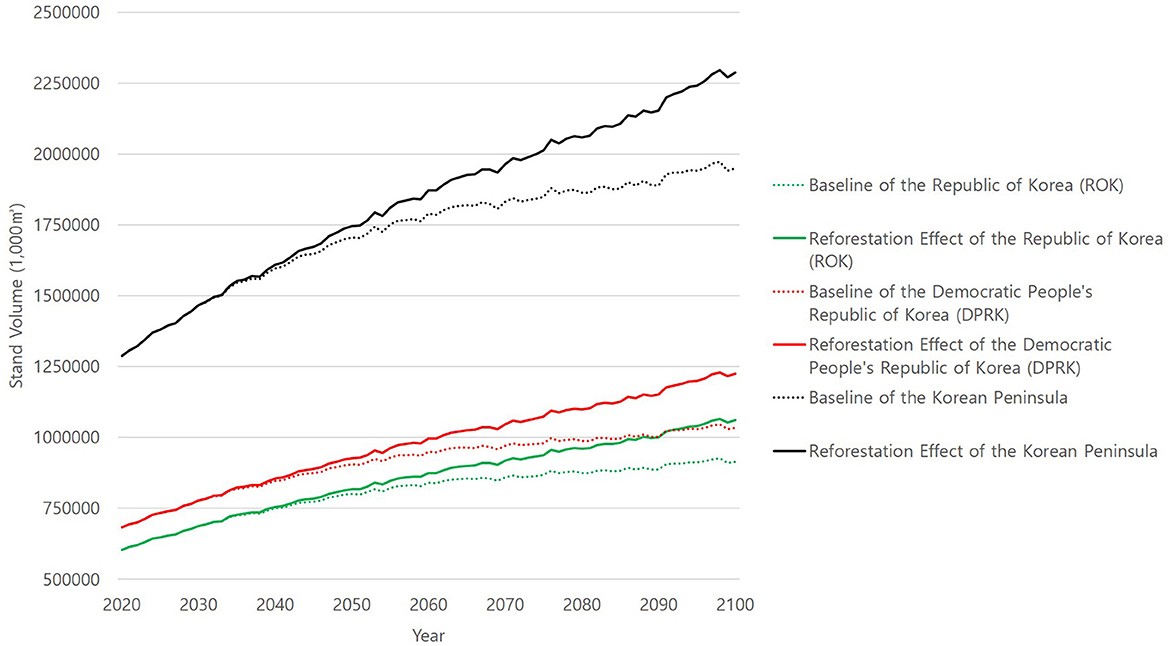
Figure 5. Prediction of stand volume between baseline and reforestation effect in the Korean Peninsula.
A net annual CO2 sequestration of 10,833,600 Mg CO2 year−1 is expected in 2050, with 20,919,200 Mg CO2 year−1 expected in 2070 in the ROK through the reforestation scenario (Figure 6). Moreover, the DPRK forest was estimated to have a potential net annual carbon sequestration of 14,236,800 Mg CO2 year−1 in 2050 and 27,490,400 Mg CO2 year−1 in 2070. The annual net carbon sequestration would be changed according to the area and period for reforestation because the carbon sequestration effect by reforestation was calculated by including both the increase for tree planting in the current year and the growth of the trees converted to the forest in the previous period. Therefore, it was determined that the potential for carbon sink expansion through reforestation was higher in the DPRK than in the ROK.
4. Discussion
As forests were internationally recognized as carbon sinks, many studies on carbon fixation have been conducted. In this process, the problem of reducing annual carbon sequestration due to forest aging has emerged (Ma et al., 2012; Kim et al., 2022). While studies on forest management have been actively conducted to overcome it, the carbon sequestration effect that could be generated by reforestation has not been presented. The ROK's 2050 Carbon Neutrality Plan emphasizes securing forest carbon sinks. To achieve the target of 34 million tons of carbon sinks by 2050, it is important to apply various forest management methods to reduce the uncertainty of achieving the goal (Yang et al., 2022). The main reasons for the relative lack of research on reforestation are the difficulty of securing the target site, meeting suitability assessment, and long-term forest management. In the case of the ROK, the cost required to secure the site and consultation with the landowner are major issues. Establishing a reforestation plan should be accompanied by an economic analysis of the costs incurred in the process of land purchase and reforestation vs. benefits arising from carbon sequestration.
The DPRK contains uncertainty in the selection of the target site. In the case of the land cover map used in this study, forests were overestimated when compared to the recently published preceding studies (Lee S.-g. et al., 2018; Piao et al., 2021). This is not only a technical problem with image processing but also closely related to land use. In the DPRK, rapid changes in land cover occur due to government-led policies, and a vicious cycle of reckless deforestation and conversion of arable land by residents continues after achieving the forest greening performance assigned to each region. Therefore, the shooting timing and resolution of images that directly reflect these characteristics could cause differences in image classification. To overcome these limitations, monitoring through short-period imaging of high-resolution satellites should be analyzed on the same method over a long period of time. Also, in the process of specifying the reforestation target at the implementation level, consideration of land cover changes in the future due to changes in socioeconomic conditions should be included, but there is a limitation in establishing a model due to a lack of data on the DPRK. To develop the socioeconomic scenarios, reliable statistics on spatial-based population change and urbanization rate are required as mentioned in the socioeconomic path scenario study for the ROK (Song et al., 2018).
As reforestation sites are applied to non-forests in the present, they are likely to be more easily disturbed than forest renewal in terms of continuous forest maintenance. In the A/R CDM, carbon sequestration is calculated through post-planting monitoring and follow-up management, sustainable forest maintenance is the key to being recognized for carbon sequestration. In the DPRK's reforestation process, this problem could be highlighted. When intending to use the DPRK as an overseas reforestation target, international regulations must be followed to enable long-term forest management independent of the unstable political situation. In addition, as the annual reforestation area is achievable when there is no problem with nursery stock supply, seedling production and transportation plans need to be established. There are practical limits to supplying the entire amount required for reforestation from abroad. Mass production of seedlings suitable for local conditions is necessary through advanced technical support and seed supply to local nurseries. In the case of the DPRK, to overcome its own technical limitations, it is receiving support for the construction of nurseries through non-political international organizations, and these facilities will be able to play a major role in supplying seedlings.
5. Conclusion
The Korean Peninsula was an area that was successfully reforested from degraded forest until the 1970s, but changes in land cover occurred due to economic differences after the 1980s. As a result of analyzing the satellite image data, the ROK was characterized by an increase in the number of settlements and a decrease in cropland, and forests increased by 1,544 km2. Since the 1980s, the DPRK has converted forests to cropland, resulting in forest loss of 7,526 km2 by the late 2010s. The effect of greening the space converted from past forests to cropland, wetland, and bare ground was analyzed to have an annual net carbon sequestration of 10,833,600 Mg CO2 year−1 in the ROK and 14,236,800 Mg CO2 year−1 in the DPRK at 2050. Considering that the forest sector target proposed in the ROK's 2050 Carbon Neutrality Plan is 34,000,000 Mg CO2 year−1, reforestation is a resource that could be utilized along with carbon enhancement through the renewal of forests maintained as forests. In terms of the international business of securing carbon sinks, the DPRK is free from land ownership issues and has recently been promoting a forest greening policy, so it has a high potential to serve as an overseas target for countries whose forest coverage has reached its limit.
Data availability statement
The original contributions presented in the study are included in the article/supplementary material, further inquiries can be directed to the corresponding author.
Author contributions
S-gL: writing-original draft and data analysis. H-JK: supervision and writing-review and editing. All authors read and agreed to the final version of the manuscript.
Funding
This work was performed with the support of a cooperative research program for agriculture science and technology development (Project No. PJ014923022023) by the Rural Development Administration, the Republic of Korea.
Conflict of interest
The authors declare that the research was conducted in the absence of any commercial or financial relationships that could be construed as a potential conflict of interest.
Publisher's note
All claims expressed in this article are solely those of the authors and do not necessarily represent those of their affiliated organizations, or those of the publisher, the editors and the reviewers. Any product that may be evaluated in this article, or claim that may be made by its manufacturer, is not guaranteed or endorsed by the publisher.
References
Başkent, E. Z., Keleş, S., Kadiogullari, A. I., and Bingöl, Ö. (2011). Quantifying the effects of forest management strategies on the production of forest values: timber, carbon, oxygen, water, and soil. Environ. Model. Assess. 16, 145–152. doi: 10.1007/s10666-010-9238-y
Byeon, J. (2014). Forest Change in the DPRK and Strengthen Ability for Recovery. KAST: Seongnam, Republic of Korea.
Choi, Y., Lim, C. H., Chung, H. I., Kim, Y., Cho, H. J., Hwang, J., et al. (2021). Forest management can mitigate negative impacts of climate and land-use change on plant biodiversity: Insights from the Republic of Korea. J. Environ. Manage. 288, 112400. doi: 10.1016/j.jenvman.2021.112400
Crespo Cuaresma, J., Danylo, O., Fritz, S., Hofer, M., Kharas, H., and Laso Bayas, J. C. (2020). What do we know about poverty in North Korea?. Palgrave Commun. 6, 1–8. doi: 10.1057/s41599-020-0417-4
FAO (2006). National Action Plan to combat Desertification / Land degradation in Democratic People's Republic of Korea (2006-2010). FAO.
Fukushima, T. (2013). The significance of CSR in A/R CDM promotion from the case study of Japan: a focus on corporate forest-related activities and emission trading. J. For. Res. 18, 293–304. doi: 10.1007/s10310-012-0351-4
Hong, M., Song, C., Kim, M., Kim, J., Lee, S. G., Lim, C. H., et al. (2022). Application of integrated Korean forest growth dynamics model to meet NDC target by considering forest management scenarios and budget. Carbon Balance Manage. 17, 1–18. doi: 10.1186/s13021-022-00208-8
Kang, S., and Choi, W. (2014). Forest cover changes in North Korea since the 1980s. Reg. Environ. Change 14, 347–354. doi: 10.1007/s10113-013-0497-4
Kim, G., Kim, J., Ko, Y., Eyman, O. T. G., Chowdhury, S., Adiwal, J., et al. (2021). How do nature-based solutions improve environmental and socio-economic resilience to achieve the sustainable development goals? reforestation and afforestation cases from the Republic of Korea. Sustainability 13, 12171. doi: 10.3390/su132112171
Kim, H. S., Noulèkoun, F., Noh, N. J., and Son, Y. W. (2022). Future projection of CO2 absorption and N2O emissions of the south korean forests under climate change scenarios: toward net-zero CO2 emissions by 2050 and beyond. Forests 13, 1076. doi: 10.3390/f13071076
Klein, I., Gessner, U., and Kuenzer, C. (2012). Regional land cover mapping and change detection in Central Asia using MODIS time-series. Appl. Geograph., 35, 219–234. doi: 10.1016/j.apgeog.2012.06.016
Lee, S.-g., Choi, H.-A., Yoo, H., Song, C., Cha, S., Bae, S.-W., et al. (2018). Restoration plan for degraded forest in the democratic people's Republic of Korea considering suitable tree species and spatial distribution. Sustainability 10, 856. doi: 10.3390/su10030856
Lim, C. H., Choi, Y., Kim, M., Jeon, S. W., and Lee, W. K. (2017). Impact of deforestation on agro-environmental variables in cropland, North Korea. Sustainability 9, 1354. doi: 10.3390/su9081354
Lim, C. H., Song, C., Choi, Y., Jeon, S. W., and Lee, W. K. (2019). Decoupling of forest water supply and agricultural water demand attributable to deforestation in North Korea. J. Environ. Manage. 248, 109256. doi: 10.1016/j.jenvman.2019.07.027
Ma, Z., Peng, C., Zhu, Q., Chen, H., Yu, G., Li, W., et al. (2012). Regional drought-induced reduction in the biomass carbon sink of Canada's boreal forests. Proceed. Nat. Acad. Sci. 109, 2423–2427. doi: 10.1073/pnas.1111576109
Nevle, R. J., and Bird, D. K. (2008). Effects of syn-pandemic fire reduction and reforestation in the tropical Americas on atmospheric CO2 during European conquest. Palaeogeograph. Palaeoclimatol. Palaeoecol. 264, 25–38. doi: 10.1016/j.palaeo.2008.03.008
Park, K. S., and Park, S. Y. (2012). The rehabilitation of North Korea's Devastated Forest: with focus on the case of South Korea. North Korean Stud. 8, 133–159. doi: 10.23040/kcidoi.2012.8.1.005
Piao, Y., Jeong, S., Park, S., and Lee, D. (2021). Analysis of land use and land cover change using time-series data and random forest in North Korea. Rem. Sens. 13, 3501. doi: 10.3390/rs13173501
Saeed, S., Ashraf, M. I., Ahmad, A., and Rahman, Z. (2016). The Bela forest ecosystem of district Jhelum, a potential carbon sink. Pak. J. Bot. 48, 121–129.
Seo, Y., Lee, D., and Choi, J. (2018). Growth pattern analysis of major coniferous tree species in South Korea. Forest Sci. Technol. 14, 1–6. doi: 10.1080/21580103.2017.1409660
Son, Y. M., Lee, G. H., Kim, R., Pyo, J. K., Park, I. H., Son, Y. W., et al. (2010). Carbon emission factors by major tree species for forest greenhouse gas inventory. Seoul 2010, 2658.
Song, C., Kim, S. J., Moon, J., Lee, S. J., Lee, W., Kim, N., et al. (2017). Classification of global land development phases by forest and GDP changes for appropriate land management in the mid-latitude. Sustainability 9, 1342. doi: 10.3390/su9081342
Song, C., Yoo, S., Kim, M., Lim, C. H., Kim, J., Kim, S. J., et al. (2018). Estimation of future land cover considering shared socioeconomic pathways using scenario generators. J. Clim. Change Res. 9, 223–234. doi: 10.15531/KSCCR.2018.9.3.223
Teuling, A. J., De Badts, E. A., Jansen, F. A., Fuchs, R., Buitink, J., Hoek van Dijke, A. J., et al. (2019). Climate change, reforestation/afforestation, and urbanization impacts on evapotranspiration and streamflow in Europe. Hydrol. Earth Syst. Sci. 23, 3631–3652. doi: 10.5194/hess-23-3631-2019
UNFCCC (2002a). Report of the Conference of the Parties on its Seventh Session, Held in Marrakech from 29 October−10 November 2001. Addendum Part Two: Action Taken by the Conference of the Parties, vol I (FCCC/CP/2001/13/Add. 1). United Nations Framework Convention on Climate Change Secretariat, Bonn, Germany
UNFCCC (2002b). Report of the Conference of the Parties on its Seventh Session, Held in Marrakech from 29 October−10 November 2001. Addendum Part Two: Action Taken by the Conference of the Parties, vol II (FCCC/CP/2001/13/Add. 1). United Nations Framework Convention on Climate Change Secretariat, Bonn, Germany
Wang, B., Waters, C., Anwar, M. R., Cowie, A., Li Liu, D., Summers, D., et al. (2022). Future climate impacts on forest growth and implications for carbon sequestration through reforestation in southeast Australia. J. Environ. Manage. 302, 113964. doi: 10.1016/j.jenvman.2021.113964
Yang, C., Kwon, H., Bang, B., Jeong, S., and Lee, U. (2022). Role of biomass as low-carbon energy source in the era of net zero emissions. Fuel 328, 125206. doi: 10.1016/j.fuel.2022.125206
Yoo, S. H., Cho, Y., Son, Y., and Lee, W. K. (2010). A policy recommendation for the successful CDM A/R Projects. J. Energy Clim. Chang. 5, 51–64.
Yu, H., Zhang, B., and Wang, Z. (2018). Comparative study on changes of croplands between North Korea and South Korea during 1990–2015. Chinese Geographic. Sci. 28, 920–934. doi: 10.1007/s11769-018-0985-z
Keywords: reforestation, carbon sink, carbon dioxide sequestration, land cover change, forest management scenarios
Citation: Lee S-g and Kim H-J (2023) Spatiotemporal approach for estimating potential CO2 sequestration by reforestation in the Korean Peninsula. Front. For. Glob. Change 6:1106630. doi: 10.3389/ffgc.2023.1106630
Received: 24 November 2022; Accepted: 12 June 2023;
Published: 02 October 2023.
Edited by:
Ling Zhang, Jiangxi Agricultural University, ChinaReviewed by:
Chul-Hee Lim, Kookmin University, Republic of KoreaMoonil Kim, Pyongtaek University, Republic of Korea
Copyright © 2023 Lee and Kim. This is an open-access article distributed under the terms of the Creative Commons Attribution License (CC BY). The use, distribution or reproduction in other forums is permitted, provided the original author(s) and the copyright owner(s) are credited and that the original publication in this journal is cited, in accordance with accepted academic practice. No use, distribution or reproduction is permitted which does not comply with these terms.
*Correspondence: Hyun-Jun Kim, aGpraW0wODM3QGNob25uYW0uYWMua3I=
 Sle-gee Lee
Sle-gee Lee Hyun-Jun Kim2*
Hyun-Jun Kim2*